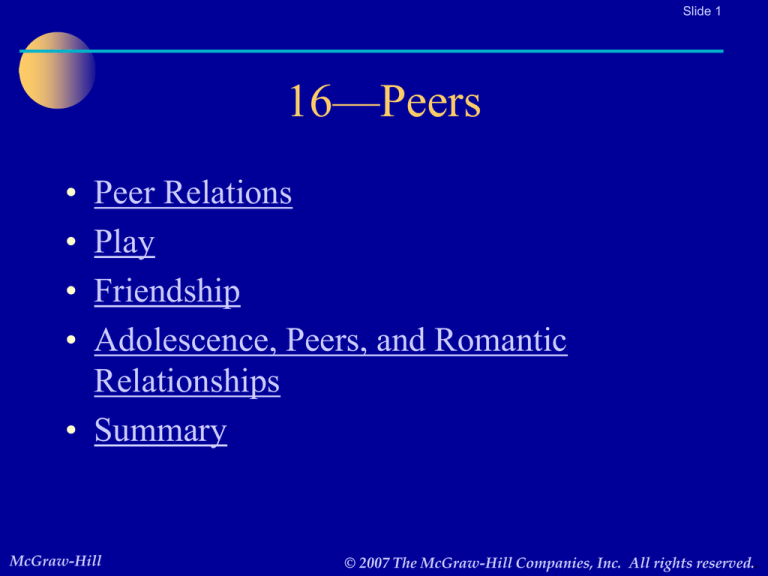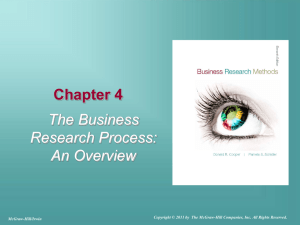
Slide 1
16—Peers
•
•
•
•
Peer Relations
Play
Friendship
Adolescence, Peers, and Romantic
Relationships
• Summary
McGraw-Hill
© 2007 The McGraw-Hill Companies, Inc. All rights reserved..
Slide 2
Peer Relations
• Peer Group Functions
– Peers: Children of about the same age or
maturity level.
– One of the most important functions of the peer
group is to provide a source of information and
comparison about the world outside the family.
– Peer interactions also fill socioemotional needs.
McGraw-Hill
© 2007 The McGraw-Hill Companies, Inc. All rights reserved..
Slide 3
Peer Relations
• The Developmental Course of Peer
Relations in Childhood
– Some researchers believe that the quality of peer
interaction in infancy provides valuable information
about social development (Vandell, 1985).
– The preference for spending time with same-sex
playmates begins around age 3 and increases in early
childhood, with reciprocity becoming important as
children enter the elementary school years.
– Children spend an increasing amount of time in peer
interaction during middle and late childhood and
adolescence.
McGraw-Hill
© 2007 The McGraw-Hill Companies, Inc. All rights reserved..
Slide 4
Peer Relations
• The Developmental Course of Peer
Relations in Childhood
– Gender influences the composition and size of
children’s interactions, with girls’ groups being smaller
and more intimate.
– Boys are more likely to engage in rough-and-tumble
play, competition, conflict, ego displays, risk taking,
and dominance seeking, while girls are more likely to
engage in collaborative discourse.
McGraw-Hill
© 2007 The McGraw-Hill Companies, Inc. All rights reserved..
Slide 5
Peer Relations
• The Distinct but Coordinated Worlds of ParentChild and Peer Relations
– Parental Influence
• Affects children’s peer relations directly and indirectly.
• Parents coach their children in ways of relating to
peers, and those who frequently initiate peer contacts
for preschool children are more accepted by their peers
and have more prosocial behavior.
• Parents manage their children’s lives and opportunities
for interacting with peers.
McGraw-Hill
© 2007 The McGraw-Hill Companies, Inc. All rights reserved..
Slide 6
Peer Relations
• Parental Influence (continued)
• Parent-child relationships serve as emotional bases
for exploring and enjoying peer relations.
– Bullies’ parents are rejecting, authoritarian, and
permissive about aggression.
– Whipping boys’ parents are anxious and
overprotective.
– Well-adjusted boys’ parents do not sanction
aggression and are responsively involved.
McGraw-Hill
© 2007 The McGraw-Hill Companies, Inc. All rights reserved..
Slide 7
Peer Relations
Peer Aggression and Parent-Child
Relationship Histories
• Refer to Figure 16.1
McGraw-Hill
© 2007 The McGraw-Hill Companies, Inc. All rights reserved..
Slide 8
Peer Relations
• Social Cognition and Emotion
– Perspective Taking: Taking another’s point of view.
• Perspective-taking skills have been linked with the
quality of peer relations, especially in the
elementary school years.
– Social Information-Processing Skills
• Kenneth Dodge (1993) argues that children go
through five steps in processing information about
their social world: decoding social cues,
interpreting, searching for a response, selecting an
optimal response, and enacting it.
McGraw-Hill
© 2007 The McGraw-Hill Companies, Inc. All rights reserved..
Slide 9
Peer Relations
The Development of Communication Skills
• Refer to Figure 16.2
McGraw-Hill
© 2007 The McGraw-Hill Companies, Inc. All rights reserved..
Slide 10
Peer Relations
• Social Cognition and Emotion (continued)
– Social Knowledge
• The social cognitive perspective views children who
are maladjusted as lacking social cognitive skills to
interact effectively with others (Rabiner et al.,
1991).
– Emotion
• The ability to regulate emotion is linked to
successful peer relations.
McGraw-Hill
© 2007 The McGraw-Hill Companies, Inc. All rights reserved..
Slide 11
Peer Relations
• Peer Statuses
– Popular children are frequently nominated as a best
friend and are rarely disliked by their peers.
– Average children receive an average number of
positive and negative nominations from peers.
– Neglected children are infrequently nominated as a
best friend but are not disliked by their peers.
– Rejected children are infrequently nominated as a best
friend and are actively disliked by their peers.
– Controversial children are frequently nominated both
as someone’s best friend and as being disliked.
McGraw-Hill
© 2007 The McGraw-Hill Companies, Inc. All rights reserved..
Slide 12
Peer Relations
• Peer Statuses (continued)
– Rejected children often have more serious adjustment
problems than those who are neglected.
– Being rejected by peers and being aggressive forecasts
problems, but not all rejected children are aggressive.
– Neglected and rejected children can be trained to
interact more effectively with their peers; however, it is
difficult to improve the social skills of adolescents who
are actively disliked and rejected.
McGraw-Hill
© 2007 The McGraw-Hill Companies, Inc. All rights reserved..
Slide 13
Peer Relations
• Bullying
– Significant numbers of students are victimized by
bullies.
– Bullies are more likely to have low grades and to
smoke and drink alcohol.
– Victims of bullies are more lonely, have difficulty
making friends, and have a higher incidence of
headaches, sleeping problems, abdominal pain, fatigue,
and depression.
– Bully victims are the most troubled, displaying high
levels of conduct, school, and relationship problems.
McGraw-Hill
© 2007 The McGraw-Hill Companies, Inc. All rights reserved..
Slide 14
Peer Relations
Bullying Behaviors among U.S. Youth
• Refer to Figure 16.3
McGraw-Hill
© 2007 The McGraw-Hill Companies, Inc. All rights reserved..
Slide 15
Peer Relations
• The Role of Culture in Peer Relations
– Peer groups are often segregated according to
socioeconomic status and ethnicity.
– Middle-SES students often assume leadership roles in
formal organizations, but African American and lowincome adolescents are able to gain parity or surpass
middle- and upper-SES adolescents in athletic groups.
– For many ethnic minority youth, their own ethnic group
provides a sense of brotherhood or sisterhood.
– In some cultures, peers assume adult responsibilities.
McGraw-Hill
© 2007 The McGraw-Hill Companies, Inc. All rights reserved..
Slide 16
Review and Reflect: Learning
Goal 1
• Discuss peer relations in childhood
– Review
• What are the functions of peer groups?
• What is the developmental course of peer relations
in childhood?
• How are the worlds of parents and peers distinct but
coordinated?
McGraw-Hill
© 2007 The McGraw-Hill Companies, Inc. All rights reserved..
Slide 17
Review and Reflect: Learning
Goal 1
– Review (continued)
• How is social cognition involved in peer relations?
How is emotion involved in peer relations?
• How are peer statuses related to development?
• What is the nature of bullying?
• How are peer relations influenced by culture?
McGraw-Hill
© 2007 The McGraw-Hill Companies, Inc. All rights reserved..
Slide 18
Review and Reflect: Learning
Goal 1
– Reflect
• Think back to your middle school/junior high and
high school years. What was your relationship with
your parents like? Were you securely attached or
insecurely attached to them? How do you think your
relationship with your parents affected your
friendship and peer relations?
McGraw-Hill
© 2007 The McGraw-Hill Companies, Inc. All rights reserved..
Slide 19
Play
• Play
– A pleasurable activity that is engaged in for its own
sake; social play is one type of play.
• Play’s Function
– Play is essential to a young child’s health.
• Play therapy is used by therapists to allow children
to work off frustrations and to provide an
opportunity for analyzing children’s conflicts and
ways of coping. Children may feel less threatened
and be more likely to express their true feelings in
the context of play.
McGraw-Hill
© 2007 The McGraw-Hill Companies, Inc. All rights reserved..
Slide 20
Play
• Play’s Function (continued)
– Play releases tension, advances cognitive development,
and increases exploration.
– Play also increases affiliation with peers, raising the
probability that children will interact and converse with
each other.
– During play, children practice the roles they will
assume later in life.
McGraw-Hill
© 2007 The McGraw-Hill Companies, Inc. All rights reserved..
Slide 21
Play
• Parten’s Classic Study of Play
– Unoccupied play: Play in which the child is
not engaging in play as it is commonly
understood and might stand in one spot, look
around the room, or perform random
movements that do not seem to have a goal.
– Solitary play: Play in which the child plays
alone and independently of others.
McGraw-Hill
© 2007 The McGraw-Hill Companies, Inc. All rights reserved..
Slide 22
Play
• Parten’s Classic Study of Play (continued)
– Onlooker play: Play in which the child
watches other children play.
– Parallel play: Play in which the child plays
separately from others, but with toys like those
the others are using or in a manner that mimics
their play.
McGraw-Hill
© 2007 The McGraw-Hill Companies, Inc. All rights reserved..
Slide 23
Play
• Parten’s Classic Study of Play (continued)
– Associative play: Play that involves social
interaction with little or no organization.
– Cooperative play: Play that involves social
interaction in a group with a sense of group
identity and organized activity.
McGraw-Hill
© 2007 The McGraw-Hill Companies, Inc. All rights reserved..
Slide 24
Play
• Types of Play
– Sensorimotor and Practice Play
• Sensorimotor play: Behavior by infants to derive
pleasure from exercising their sensorimotor
schemas.
• Practice play: Play that involves repetition of
behavior when new skills are being learned or when
physical or mental mastery and coordination of
skills are required for games or sports. Practice play
can be engaged in throughout life.
McGraw-Hill
© 2007 The McGraw-Hill Companies, Inc. All rights reserved..
Slide 25
Play
• Types of Play (continued)
– Pretense/symbolic play: Play that occurs when
a child transforms the physical environment
into a symbol.
– Social play: Play that involves social
interactions with peers.
McGraw-Hill
© 2007 The McGraw-Hill Companies, Inc. All rights reserved..
Slide 26
Play
• Types of Play (continued)
– Constructive play: Play that combines
sensorimotor/practice repetitive activity with
symbolic representation of ideas. Constructive
play occurs when children engage in selfregulated creation or construction of a product
or a problem solution.
– Games: Activities engaged in for pleasure that
include rules and often competition with one or
more individuals.
McGraw-Hill
© 2007 The McGraw-Hill Companies, Inc. All rights reserved..
Slide 27
Review and Reflect: Learning
Goal 2
• Describe children’s play
– Review
• What are the functions of play?
• How would you describe Parten’s classic study of
play?
• What are the different types of play?
McGraw-Hill
© 2007 The McGraw-Hill Companies, Inc. All rights reserved..
Slide 28
Review and Reflect: Learning
Goal 2
– Reflect
• Do you think most young children’s lives today are
too structured? Do young children have too little
time to play? Explain.
McGraw-Hill
© 2007 The McGraw-Hill Companies, Inc. All rights reserved..
Slide 29
Friendship
• Friendship’s Functions
–
–
–
–
–
–
McGraw-Hill
Companionship
Stimulation
Physical support
Ego support
Social comparison
Intimacy/affection
© 2007 The McGraw-Hill Companies, Inc. All rights reserved..
Slide 30
Friendship
• Friendship’s Functions
– Harry Stack Sullivan (1953) contended that in
addition to parents’ influence on development,
friends also play important roles in shaping
children’s and adolescents’ well-being and
development.
• The need for intimacy intensifies during early
adolescence, motivating teenagers to seek out close
friends who support one another’s sense of personal
worth.
McGraw-Hill
© 2007 The McGraw-Hill Companies, Inc. All rights reserved..
Slide 31
Friendship
Developmental Changes in Self-Disclosing
Conversations
• Refer to Figure 16.4
McGraw-Hill
© 2007 The McGraw-Hill Companies, Inc. All rights reserved..
Slide 32
Friendship
– Willard Hartup (1996, 2000) concluded that
children often use friends as cognitive and
social resources on a regular basis.
– The quality of friendships is more positive
when friends engage in prosocial behavior and
more negative when they engage in aggressive
behavior.
McGraw-Hill
© 2007 The McGraw-Hill Companies, Inc. All rights reserved..
Slide 33
Friendship
• Similarity and Intimacy
– Friends are generally similar in age, sex, ethnicity, and
other factors; they often have similar attitudes toward
school, similar educational aspirations, and closely
aligned achievement orientations.
– Intimacy in Friendship
• Self-disclosure or the sharing of private thoughts.
• Friendship intimacy is more prominent in 13- to 16year-olds than in 10- to 13-year-olds.
• The friendships of girls are more intimate than the
friendships of boys.
McGraw-Hill
© 2007 The McGraw-Hill Companies, Inc. All rights reserved..
Slide 34
Friendship
• Mixed-Age Friendships
– Parents’ concerns that adolescents who have
older friends will be encouraged to engage in
delinquent behavior or early sexual behavior
are supported by the research, although it could
be that younger adolescents were already prone
to deviant behavior before they developed their
friendships with older youths.
McGraw-Hill
© 2007 The McGraw-Hill Companies, Inc. All rights reserved..
Slide 35
Review and Reflect: Learning
Goal 3
• Explain friendship
– Review
• What are six functions of friendship? What is
Sullivan’s view of friendship?
• What role do similarity and intimacy play in
friendship?
• What is the developmental outcome of mixed-age
friendship?
McGraw-Hill
© 2007 The McGraw-Hill Companies, Inc. All rights reserved..
Slide 36
Review and Reflect: Learning
Goal 3
– Reflect
• Examine the list of six functions of friendships at
the beginning of this section. Rank order the six
functions from most (1) to least (6) important as you
were growing up.
McGraw-Hill
© 2007 The McGraw-Hill Companies, Inc. All rights reserved..
Slide 37
Adolescence, Peers, and
Romantic Relationships
• Peer Pressure and Conformity
– Conformity to peer pressure in adolescence can
be positive or negative.
– Around eighth and ninth grades, conformity to
peers peaks.
McGraw-Hill
© 2007 The McGraw-Hill Companies, Inc. All rights reserved..
Slide 38
Adolescence, Peers, and
Romantic Relationships
• Cliques and Crowds
– Cliques and crowds assume more important
roles in the lives of adolescents than children.
• Cliques: Small groups that range from 2 to about 12
individuals and average about 5 to 6 individuals.
• Cliques can form because of friendship or because
individuals engage in similar activities, and
members usually are of the same sex and about the
same age.
McGraw-Hill
© 2007 The McGraw-Hill Companies, Inc. All rights reserved..
Slide 39
Adolescence, Peers, and
Romantic Relationships
• Cliques and Crowds (continued)
• Crowds: The crowd is a larger group
structure than a clique. Adolescents usually
are members of a crowd based on reputation
and may or may not spend much time
together. Many crowds are defined by the
activities adolescents engage in.
McGraw-Hill
© 2007 The McGraw-Hill Companies, Inc. All rights reserved..
Slide 40
Adolescence, Peers, and
Romantic Relationships
• Adolescent Groups versus Child Groups
– The members of child groups often are friends or
neighborhood acquaintances, and their groups usually
are not as formalized as many adolescent groups;
adolescent groups tend to include a broader array of
members.
– Rules and regulations are usually defined more
precisely in adolescent peer groups.
– During adolescence, mixed-sex participation in groups
increases.
McGraw-Hill
© 2007 The McGraw-Hill Companies, Inc. All rights reserved..
Slide 41
Adolescence, Peers, and
Romantic Relationships
Dunphy’s Progression of Peer Group
Relations in Adolescence
• Refer to Figure 16.5
McGraw-Hill
© 2007 The McGraw-Hill Companies, Inc. All rights reserved..
Slide 42
Adolescence, Peers, and
Romantic Relationships
• Dating and Romantic Relationships
– It is through dating that more serious contacts between
the sexes occur.
– Heterosexual Romantic Relationships
• A number of developmental changes characterize
heterosexual dating.
• Adolescents often find comfort in numbers and
begin to hang out together in heterosexual groups.
• Cyberdating poses potential hazards; so does early
dating.
McGraw-Hill
© 2007 The McGraw-Hill Companies, Inc. All rights reserved..
Slide 43
Adolescence, Peers, and
Romantic Relationships
• Dating and Romantic Relationships
(continued)
– Romantic Relationships in Sexual Minority
Youth
• Most sexual minority youth have same-sex
experience but relatively few have same-sex
romantic relationships because of limited
opportunities and the social disapproval such
relationships may generate.
McGraw-Hill
© 2007 The McGraw-Hill Companies, Inc. All rights reserved..
Slide 44
Adolescence, Peers, and
Romantic Relationships
Age of Onset of Heterosexual Romantic
Activity
• Refer to Figure 16.6
McGraw-Hill
© 2007 The McGraw-Hill Companies, Inc. All rights reserved..
Slide 45
Adolescence, Peers, and
Romantic Relationships
• Dating and Romantic Relationships
(continued)
– Dating Scripts
• The cognitive models that adolescents and adults
use to guide and evaluate dating interactions.
• Male dating scripts are proactive, those of females
are reactive, and these gender differences in dating
scripts give males more power in the initial stage of
a dating relationship.
• Male and female adolescents bring different
motivations to the dating experience.
McGraw-Hill
© 2007 The McGraw-Hill Companies, Inc. All rights reserved..
Slide 46
Adolescence, Peers, and
Romantic Relationships
• Dating and Romantic Relationships
(continued)
– Emotion and Romantic Relationships
• The strong emotions of romantic relationships can
thrust adolescents into a world in which things are
turned upside down and ordinary reality recedes
from view (Larson, Clore, & Wood, 1999).
• The strong emotions of romance can have disruptive
effects on adolescents; conversely, they can also
provide a source for mastery and growth.
McGraw-Hill
© 2007 The McGraw-Hill Companies, Inc. All rights reserved..
Slide 47
Adolescence, Peers, and
Romantic Relationships
• Dating and Romantic Relationships
(continued)
– Sociocultural Contexts and Dating
• The sociocultural context exerts a powerful
influence on adolescent dating patterns and on mate
selection (Booth, 2002; Stevenson & Zusho, 2002).
• Cultural values and religious beliefs often dictate
structures for dating, thus dating can be a source of
cultural conflict for adolescents whose families have
come from cultures in which dating standards are
more strict.
McGraw-Hill
© 2007 The McGraw-Hill Companies, Inc. All rights reserved..
Slide 48
Review and Reflect: Learning
Goal 4
• Characterize peer relations and romantic
relationships in adolescence
– Review
• What is peer pressure and conformity like in
adolescence?
• How are cliques and crowds involved in adolescent
development?
• How do adolescents’ groups differ from children’s
groups?
• What is the nature of adolescent dating and romantic
relationships?
McGraw-Hill
© 2007 The McGraw-Hill Companies, Inc. All rights reserved..
Slide 49
Review and Reflect: Learning
Goal 4
– Reflect
• What were your peer relationships like during
adolescence? What peer groups were you involved
in? How did they influence your development?
What were your dating and romantic relationships
like in adolescence? If you could change anything
about the way you experienced peer relations in
adolescence, what would it be?
McGraw-Hill
© 2007 The McGraw-Hill Companies, Inc. All rights reserved..
Slide 50
Summary
• Peers are individuals who are at about the same
age or maturity level. Peers provide a means of
social comparison and a source of information
about the world outside the family.
• Some researchers believe that the quality of social
interaction with peers in infancy provides valuable
information about social development.
• Healthy family relations usually promote healthy
peer relations.
McGraw-Hill
© 2007 The McGraw-Hill Companies, Inc. All rights reserved..
Slide 51
Summary
• Perspective taking, social information-processing
skills, and social knowledge are important
dimensions of social cognition in peer relations.
• Self-regulation of emotion is associated with
positive peer relations.
• Popular children are frequently nominated as a
best friend and are rarely disliked by their peers;
average children receive an average number of
both positive and negative nominations from
peers.
McGraw-Hill
© 2007 The McGraw-Hill Companies, Inc. All rights reserved..
Slide 52
Summary
• Neglected children are infrequently nominated as
a best friend but are not disliked by their peers;
rejected children are infrequently nominated as a
best friend and are disliked by their peers.
• Rejected children often have more serious
adjustment problems than neglected children;
controversial children are frequently nominated
both as one’s best friend and as being disliked by
peers.
McGraw-Hill
© 2007 The McGraw-Hill Companies, Inc. All rights reserved..
Slide 53
Summary
• Significant numbers of students are bullied, and
this can result in problems for the victim.
• Peer relations can be influenced by culture.
• The functions of play include affiliation with
peers, tension release, advances in cognitive
development, and exploration.
• Parten examined these categories of social play:
unoccupied, solitary, onlooker, parallel,
associative, and cooperative.
McGraw-Hill
© 2007 The McGraw-Hill Companies, Inc. All rights reserved..
Slide 54
Summary
• The contemporary perspective emphasizes both
social and cognitive aspects of play.
• The functions of friendship include
companionship, stimulation, physical support, ego
support, social comparison, and
intimacy/affection.
• Sullivan argued that there is a dramatic increase in
the psychological importance and intimacy of
close friends in adolescence.
McGraw-Hill
© 2007 The McGraw-Hill Companies, Inc. All rights reserved..
Slide 55
Summary
• Similarity and intimacy are two of the most
common characteristics of friendships.
• Children and adolescents who become friends
with older individuals engage in more deviant
behaviors than their counterparts with same-age
friends.
• The pressure to conform to peers is strong during
adolescence, especially in the eighth and ninth
grade.
McGraw-Hill
© 2007 The McGraw-Hill Companies, Inc. All rights reserved..
Slide 56
Summary
• Cliques and crowds assume more importance in
the lives of adolescents than children.
• Children’s groups are less formal, less
heterogeneous, and less heterosexual than
adolescents’ groups.
• Dating takes on added importance in adolescence,
and it can have many functions.
• Early dating is linked with developmental
problems.
McGraw-Hill
© 2007 The McGraw-Hill Companies, Inc. All rights reserved..
Slide 57
Summary
• Male dating scripts are proactive, those of females
are reactive.
• Many sexual minority youth have same-sex sexual
experiences but relatively few have same-sex
romantic relationships.
• Emotions are heavily involved in adolescent
dating and romantic relationships.
• Culture can exert a powerful influence on
adolescent dating.
McGraw-Hill
© 2007 The McGraw-Hill Companies, Inc. All rights reserved..









